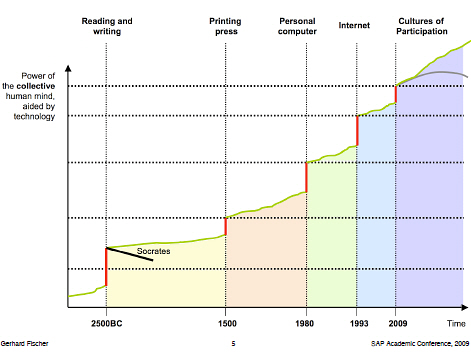'Cultures of participation' and IT success

Many important business ideas and trends, including Enterprise 2.0 and Social CRM, are rooted in social networking technologies that help individuals come together spontaneously to form collaborative, ad hoc affinity groups.
These new technologies, such as wikis and wisdom of crowds tools, remind us of the essential link between culture and collaboration in creating successful projects.
Given the significance of collaborative groups, I read with interest one particular slide in an SAP-sponsored academic research paper on peer support in enterprise software. This slide portrays the historical relative impact of various technologies on collaboration and information sharing:

Projects succeed or fail based on collaboration. Therefore, improving an organization's project success rate requires attention to cultural dimensions. For example, many companies find that communication between business and technical groups is challenging. This communication gap leads to information silos that directly impede project success.
I asked HR technology and service delivery expert, Naomi Bloom, to comment:
Ensuring that project team members have the right capabilities, are well-organized to succeed in their communications and collaboration, have the right incentives and behavioral enablers in place to support communication and collaboration as organizational imperatives, are given relevant development opportunities -- and the list goes on -- is the work of effective human resource management (HRM) applied to the needs of project-based work.
Communication and collaboration are essentially human behaviors, which can be hired for, managed, learned, incented, obstructed, evaluated and rewarded, encouraged or discouraged by an organization's HRM policies and practices. Thus, at the heart of successful project cultures is effective HRM. The two are inextricably intertwined.
When analyzing IT projects, I often use a framework that links culture to IT and business activities. Although the items shown in this diagram are non-technical, they are the true drivers of IT success or failure.
My take. "Culture of participation," as the paper terms it, is a bedrock concept describing the most basic business activity: people working together to achieve specific goals. From a narrow project failures perspective, it's high time we recognize that technology solutions alone do not increase success rates. The real answer lies in collaboration, communication, and cross-boundary participation.